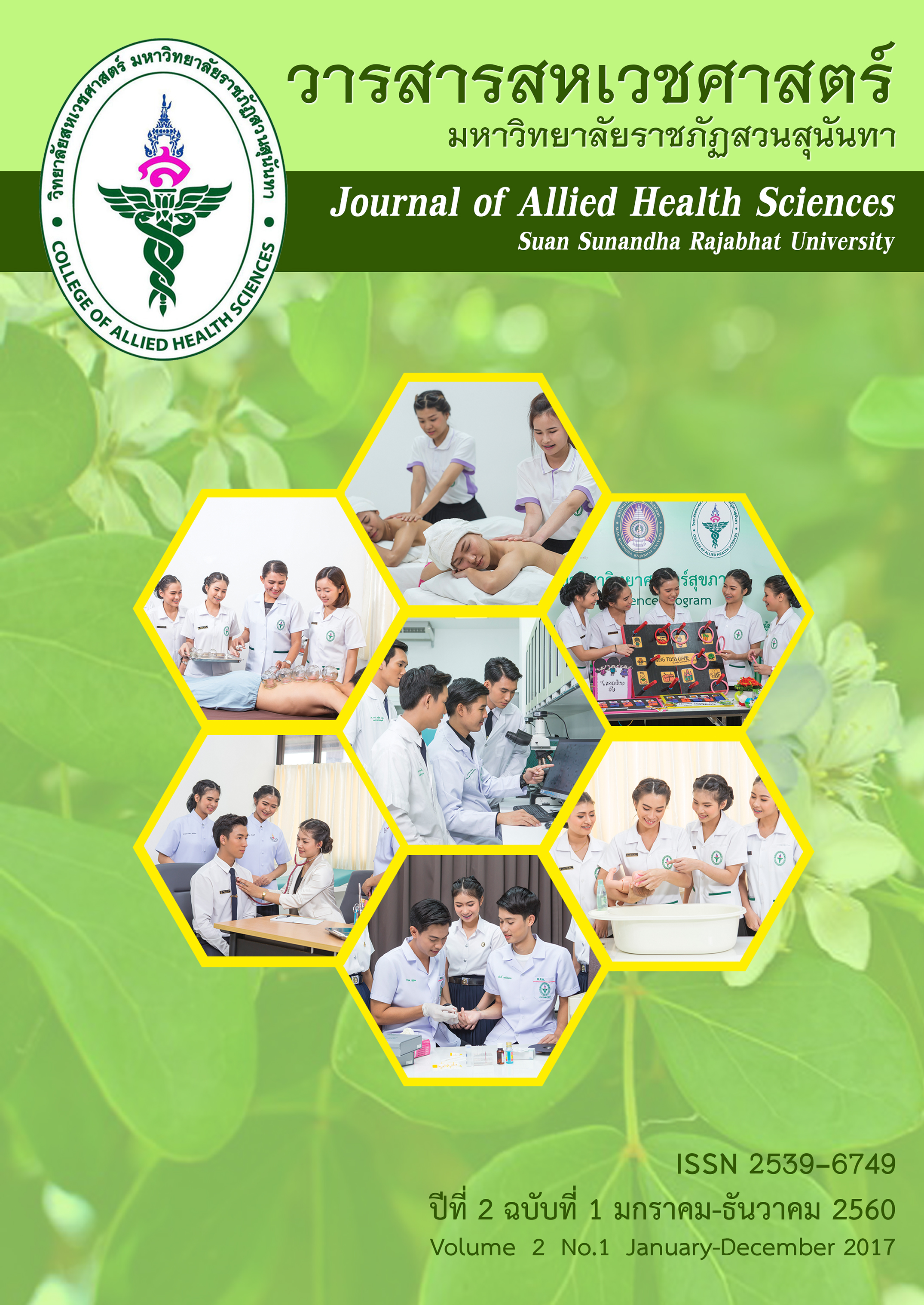ความหลากชนิดและความชุกชุมของยุงพาหะนำโรคในพื้นที่วิทยาลัยสหเวชศาสตร์ มหาวิทยาลัยราชภัฏสวนสุนันทา ศูนย์การศึกษาจังหวัดสมุทรสงคราม Species Diversity and Abundance of Mosquito Vectors in the College of Allied Health Sciences, Suan Sunandha Rajabhat University, Samut Songkhram Education Center
Main Article Content
บทคัดย่อ
ยุงเป็นแมลงชนิดหนึ่งที่มีความสำคัญในด้านการแพทย์และสาธารณสุขเนื่องจากเป็นแมลงพาหะนำโรคหลายชนิดมาสู่มนุษย์ วิทยาลัยสหเวชศาสตร์ มหาวิทยาลัยราชภัฏสวนสุนันทา ได้เริ่มเข้ามาจัดการเรียนการสอน ณ ศูนย์การศึกษาจังหวัดสมุทรสงครามในปีการศึกษา 2558 โดยตลอดระยะที่ได้เข้ามาจัดการเรียนการสอนนั้นมีปัญหายุงในพื้นที่ชุกชุม นักศึกษารวมทั้งบุคลากรต่างมีความกลัวในเรื่องโรคติดต่อที่นำโดยยุง ซึ่งมาตรการควบคุมยุงพาหะในขั้นต้นคือการฉีดพ่นยากำจัด แต่ก็ไม่ประสบความสำเร็จมากนักเนื่องจากไม่มีข้อมูลยุงพาหะในพื้นที่เพื่อใช้เป็นแนวทางในการควบคุมยุงได้อย่างถูกต้อง ซึ่งงานวิจัยนี้ได้สำรวจความหลากชนิดและความชุกชุมของยุงพาหะนำโรคในพื้นที่วิทยาลัยสหเวชศาสตร์ ช่วงเดือนสิงหาคม 2558 โดยแบ่งพื้นที่ออกเป็น 2 ส่วนได้แก่พื้นที่วิทยาลัยสหเวชศาสตร์และพื้นที่หอพักนักศึกษาเพื่อนำผลที่ได้ไปใช้ในการวางแผนควบคุมยุงพาหะทางสาธารณสุขในพื้นที่ต่อไป โดยผลการวิจัยระยะยุงตัวเต็มวัยใน 2 พื้นที่การศึกษาทั้งหมดพบยุงพาหะนำโรค 4 ชนิด จำนวนทั้งหมด 1,022 ตัว ประกอบด้วย Culex quinquefasciatus จำนวน 360 ตัว คิดเป็นร้อยละ 35.23 รองลงมา Anopheles epiroticus จำนวน 352 ตัว คิดเป็นร้อยละ 34.44 Culex sitiens จำนวน 304 ตัว คิดเป็นร้อยละ 29.75 และ Aedes aegypti จำนวน 6 ตัว คิดเป็นร้อยละ 0.59 ตามลำดับ ขณะที่การประเมินความเสี่ยงโรคไข้เลือดออกจากการสำรวจลูกน้ำยุงลายพบว่าในพื้นที่วิทยาลัยสหเวชศาสตร์ไม่มีความเสี่ยง แต่พื้นที่หอพักนักศึกษามีความเสี่ยงสูง การสำรวจระยะลูกน้ำพบในแหล่งน้ำธรรมชาติ 2 ชนิด ได้แก่ Culex sitiens และ Anopheles epiroticus โดยยุงตัวเต็มวัยที่พบมากที่สุดคือ Culex quinquefasciatus ที่เป็นพาหะนำโรคไข้สมองอักเสบเจอี และ Anopheles epiroticus ที่เป็นพาหะรองนำโรคมาลาเรีย จึงควรเฝ้าระวังทั้งสองโรคในพื้นที่ต่อไป
Mosquito is the important insect vector in medical and public health because it can transmit many diseases to human. The College of Allied Health Sciences, Suan Sunandha Rajabhat University has started to teach at Samut Songkhram Education Center in academic year 2015. Since then when we stay here, there is a major problem of abundance mosquitoes to students and staff. It fears on mosquito borne diseases. First controlling procedure was insecticide sprays to reduce the mosquito population, but unsuccessful due to lack of data on mosquito vector in the area. This research had surveyed species diversity and abundance of mosquito vectors in the College of Allied Health Sciences by dividing into 2 parts included the college area and the student’s dormitory area for using mosquito vectors control way. The research results of species diversity and abundance of adult mosquitoes in August 2015 showed 4 species of 1,022 mosquitoes including Culex quinquefasciatus (35.23%), Anopheles epiroticus (34.44%), Culex sitiens (29.75%) and Aedes aegypti (0.59%). DHF risk assessment from Aedes larvae collection, the college part is not the risk area, but the student’s dormitory part is high risk. 2 Species of the mosquito larvae in natural water sources were found including Culex sitiens and Anopheles epiroticus. The results showed high numbers of Culex quinquefasciatus and Anopheles epiroticus those are the vectors of Japanese encephalitis and malaria, hence the surveillance of these diseases should be careful.

